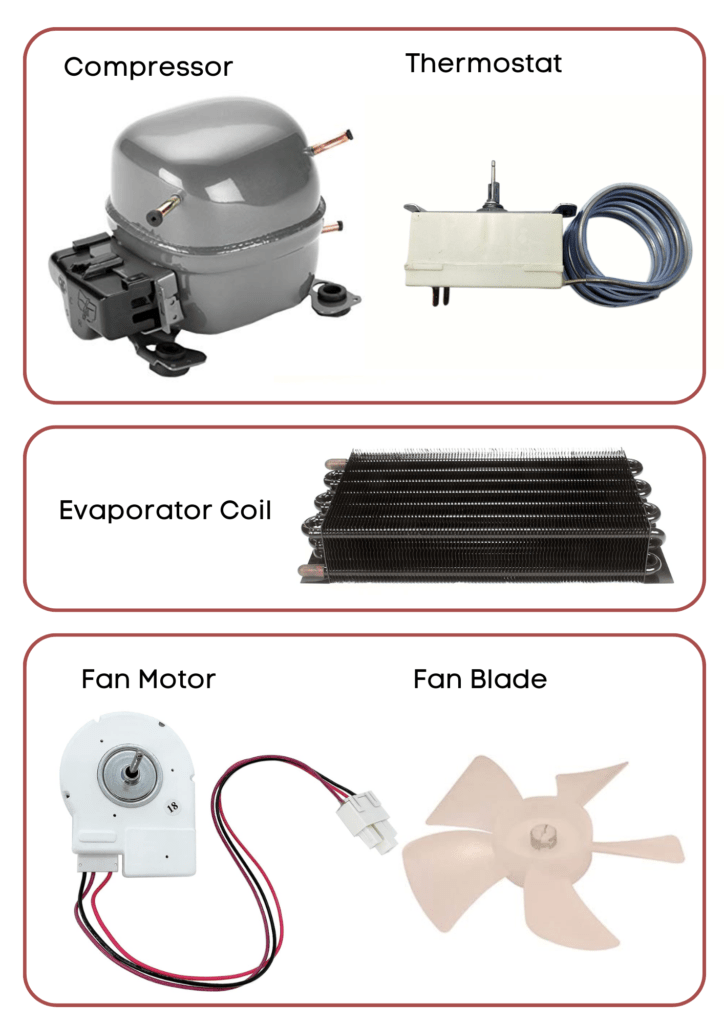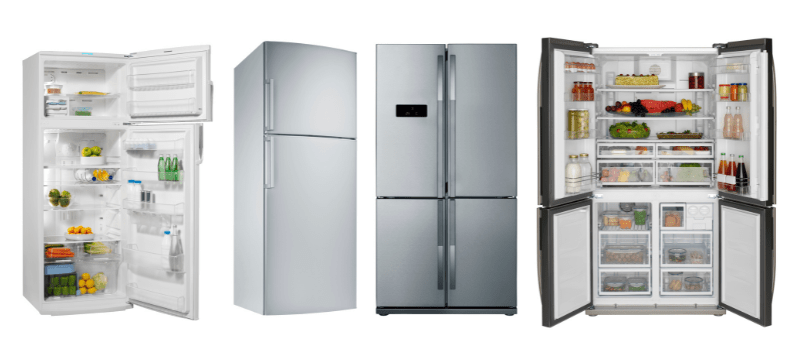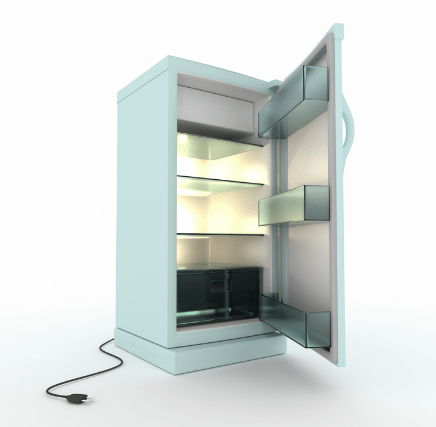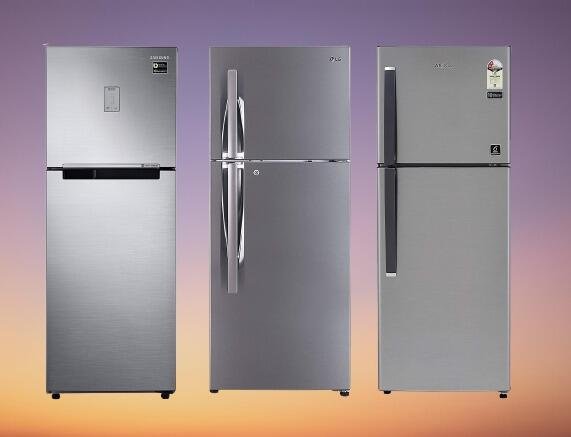Is your refrigerator full of cold air and ice? Do you ever wonder how a refrigerator works? Check out this blog post to learn all about refrigerators! We’ll go over the different parts of a refrigerator and what they do, as well as how refrigeration happens. You’ll be a refrigerator expert in no time!
The history of the refrigerator
It is estimated that the average Indian family spends 4k to 6k per year on their energy bill to operate their fridge. Despite its commonplace status in the home, many people do not know how this essential kitchen appliance came to be. The refrigerator has a long and interesting history dating back to the early 1800s.
The first known attempt at creating a machine that could cool food was by William Cullen, a Scottish doctor, in 1748. Cullen made a machine that cooled water by letting it evaporate, but it couldn’t keep the water at the same temperature and wasn’t useful for everyday life. In 1834, an American inventor named Jacob Perkins created the first working refrigeration system. Perkins’s machine used diethyl ether and compressed air to create low temperatures.
The refrigerator has come a long way since then. Here is a brief timeline of some of the most important milestones in the history of refrigeration:
- 1876 – Carl von Linde develops a machine that uses ammonia to produce cold air, revolutionizing the refrigeration industry.
- 1900 – Willis Carrier invents the first modern air conditioning system, which is used to cool factories and office buildings.
- 1935 – The first home refrigerator is released to the public by Frigidaire.
- 1942 – The first self-defrosting refrigerator is invented by General Electric.
- 1973 – The first side-by-side refrigerator is released by LG.
- 1993 – The first American fridge with a water and ice dispenser on the door is introduced by Samsung.
- 2004 – The Energy Star program is created to promote energy-efficient appliances, including refrigerators.
Today, there are a variety of different types of refrigerators available on the market, from traditional top-freezer models to side-by-side fridges and bottom-freezer units. In addition, there are now also mini fridges and counter-depth models that can be customized to fit your specific needs. With so many options available, it can be difficult to decide which fridge is right for you. But by understanding the different features and technologies involved, you can make an informed decision and find the perfect refrigerator for your home.
The working principle of the refrigerator
A refrigerator keeps our food cold and fresh. But have you ever wondered how it actually works? They actually work using a process called the Rankine cycle. It is a phenomenon used in refrigerators, air conditioners, and other applications where low-temperature operation is necessary.
Freon is a type of refrigerant that is used in most modern refrigerators. This refrigerant is a fluid that changes from a gas to a liquid and back again. The refrigerant absorbs heat from the air inside the fridge and then evaporates. The heat is then released into the atmosphere outside the fridge.
The compressor is what helps circulate the refrigerant through the fridge. The compressor squeezes the refrigerant gas and changes it into a liquid. This liquid is then moved through coils on the back of the fridge. These coils release heat into the atmosphere, cooling the liquid in the process.
This process continues on a continuous loop, keeping the air inside the fridge cool and fresh. In addition to the compressor, most modern refrigerators also have a fan that helps to circulate the cold air evenly throughout the fridge. By understanding how a refrigerator works, you can be sure to keep your food fresh for longer.
Important parts of the refrigerator?
A refrigerator is a complex machine that uses a variety of different technologies to keep your food cold.

Compressor
The most important part of a refrigerator is the compressor. Refrigerator compressors work by transferring energy from an electric motor to a compressor wheel which in turn creates a vacuum and cools the surrounding air. This process is repeated multiple times per second to maintain refrigeration levels.
Thermostat
The thermostat controls the temperature inside the refrigerator and signals to the compressor when it needs to turn on or off. Typically, a thermostat is adjusted using a knob or digital display on the exterior of the fridge. Many modern refrigerators also have an automatic defrost feature, which uses a heating element to melt any ice buildup on the inside of the fridge.
Evaporator coils
The evaporator coils are initially cooled by the refrigerant as it circulates through them. As the air inside the fridge is warmed by food or heat from outside, it is drawn over the cold evaporator coils and chilled before being circulated back into the fridge.
Fan
The fan helps to circulate air throughout the refrigerator and helps to keep the coolant circulating properly. The fan is typically located in the freezer section of the refrigerator and is usually a blade shape.
Door seals
The rubber or plastic seals on the edges of the fridge and freezer doors help keep cold air inside, preventing it from escaping when the doors are opened. It is important to make sure that these seals are clean and in good condition, as any damage can result in lost cold air and higher energy consumption.
Interior shelves and drawers
Inside the fridge, shelves and drawers provide storage for food and help to keep it organized. These can be adjustable or fixed in place, and some refrigerators also have additional features such as crisper drawers for produce or separate deli/meat drawers. The drawers help to hold food and drinks inside the refrigerator.
Lighting
Many modern refrigerators have interior lighting to make it easier to see the contents of the fridge. This lighting is usually activated when the door is opened and maybe a traditional bulb or a more energy-efficient LED light. The light bulb is typically located in the ceiling of the fridge and is usually a standard light bulb shape.
Drain pan
A drain pan at the bottom of the fridge collects any water from defrosting or condensation, and it should be regularly emptied to prevent mold or odors. Some refrigerators also have a drain tube connected to the drain pan, which can be used to continuously remove excess water.
By understanding how each of these components works together, you can ensure that your refrigerator is running efficiently and keeping your food properly cooled. And next time someone asks how a refrigerator works, you’ll be able to give them a detailed explanation.
Different types of refrigerator
Refrigerators come in a variety of different sizes and styles, and each one has its own unique features. Here is a brief overview of the common types of refrigerators:

Standard refrigerator
A standard refrigerator is the most common type of fridge, and it typically has a top freezer and a bottom fridge section. The freezer is usually located on the top, as it is easier to access than the fridge section at the bottom. This type of fridge is perfect for a family household, as it offers plenty of storage space for food and beverages. In India, the most widely used standard refrigerators include single-door and double-door refrigerators.
Bottom freezer refrigerator
A bottom freezer refrigerator is similar to a standard refrigerator, but with the freezer located at the bottom instead of the top. This style is becoming more popular, as it offers easy access to frozen food and can save on energy costs as the compressor does not have to work as hard to keep the freezer cold.
French door refrigerator
A French door refrigerator has two doors that open out from the center, similar to a cabinet door. This style offers a lot of storage space inside, as well as a separate drawer for vegetables or ice cream. The French door refrigerator is perfect for large families or those who want a sleek, modern look in their kitchen.
Side-by-side refrigerator
A side-by-side refrigerator is divided into two sections, with one section on each side of the door. This style is perfect for those who want evenly sized sections for their food, as well as easy access to both refrigerated and frozen food items.
Compact refrigerator
A compact refrigerator is a small, personal-sized fridge that is perfect for dorm rooms or small kitchens. It typically has one or two shelves and enough room to store a few food items or drinks. Compact refrigerators are a perfect choice for bachelor’s and hostel students because they’re not as big as regular-sized refrigerators, but they still have enough space to store your food.

Additionally, these units typically have lower power needs, which is great if you’re on a budget. Finally, most compact refrigerators come with features like water and ice dispensers and built-in shelves so you can organize your groceries easily.
Also read: The Pros and Cons of Different Types of Refrigerators – Which one you should buy?
Uses of refrigerator
Whether you have a domestic or commercial requirement, there are several ways you can use a refrigerator.
Food Storage
One of the most common uses for refrigerators is food storage. Refrigerators keep food fresh for longer periods of time by maintaining a temperature that is below the ambient temperature, which slows down the growth of bacteria. Bacteria can cause food to spoil, so keeping food in a refrigerator, will last longer.
Beverage Storage
Another common use for refrigerators is storing beverages. Many people like to keep their beverages cold, and a refrigerator is a perfect way to do this. Whether you are storing soda, beer, or wine, a refrigerator will keep your beverages at a temperature that is ideal for consumption.

Leftovers
Refrigerators are also great for storing leftovers. If you have cooked too much food or have leftover food from a restaurant, you can store it in the refrigerator and enjoy it later. Leftovers can be stored in the fridge for several days before they need to be thrown out.
Cold Treats
In addition to storing food and beverages, refrigerators can also be used to store cold treats such as ice cream and popsicles. Ice cream and other frozen desserts are best kept in the freezer section of the fridge, where they will stay cold and not melt. Popsicles can also be stored in the fridge, but they will need to be eaten within a few days as they will start to soften and lose their shape if left in the fridge for too long.
Make Ahead Meals
Another great use for refrigerators is making ahead meals. If you know you are going to be busy during the week, you can make meals on the weekend and store them in the fridge until you are ready to eat them. This way, you can have a healthy meal without having to spend time cooking during the week.
Making Ice Cream
Ice cream is another popular use for refrigerators. Ice cream is made by combining milk or cream with sugar and flavorings, and then freezing the mixture. A refrigerator is necessary to keep the ice cream cold enough to prevent it from melting.
Making Yogurt
Yogurt is another dairy product that can be made using a refrigerator. Yogurt is made by combining milk with live bacteria cultures and then allowing the mixture to ferment at a warm temperature. Once the yogurt has fermented, it must be stored in the fridge to prevent it from spoiling.
Chilling Wine
Wine is another beverage that benefits from being stored in the fridge. Red wine should be served at room temperature, while white wine should be served chilled. By chilling white wine in the fridge, you can help to preserve its flavor and prevent it from becoming too vinegary.
The advantages of the refrigerator
Keep food fresh for a longer period of time
One of the main advantages of the refrigerator is that it can keep food fresh for a much longer period of time than other storage methods, such as pantries or cupboards. This is because the refrigerator keeps food at a temperature that is below the ambient temperature, which slows down the growth of bacteria that can cause food to spoil. Additionally, the fridge can also help to prevent the growth of mold and other fungi.
Help to preserve the nutrients in food
Another advantage of the refrigerator is that it can help to preserve the nutrients in food. When food is stored at a lower temperature, the metabolic processes that occur within the food are slowed down. This means that there is less chance for nutrients to be lost through oxidation or other chemical reactions. In addition to extending the shelf life of food, refrigeration can also preserve the taste, texture, and nutrients of foods.
Can save you money
Refrigerators use a variety of different cooling methods, but most operate using the principles of thermodynamics. A refrigerator with a high star rating can save you money in the long run, as it can help to reduce food waste. When food is stored properly, it will last longer and you will be less likely to throw away spoiled or rotten food. Additionally, you may be able to buy in bulk and take advantage of sales when you know that your food will stay fresh in the fridge.
Make meal planning easier
Another advantage of having a fridge is that it can make meal planning easier. When you have a good stock of fresh ingredients on hand, it becomes much simpler to plan and prepare healthy meals. Additionally, you can pre-prepare meals or snacks and store them in the fridge for later, which can save you time on busy days.
Offers healthy options when eating out
By trapping cold air inside the fridge and circulating it around the food, refrigerators can lower the temperature of the food, slowing down bacterial growth and spoilage. If you are eating out at a restaurant or cafe that does not have many healthy options, you can always ask if they have anything available in the fridge. Many places will have yogurts, fruits, or vegetable salads that you can enjoy as a healthier alternative to greasy or processed foods
The disadvantages of the refrigerator
Refrigerators are expensive
One of the main disadvantages of refrigerators is that they are expensive. The average cost of a new refrigerator is between Rs. 10k and 1 lac, which is a significant investment for most people. Additionally, refrigerators require regular maintenance and repairs, which can add to the overall cost of owning one.
Refrigerators use a lot of energy.
This is because the refrigerator needs to keep food cold. To do this, it uses electricity to run the compressor and fan. The refrigerator also uses electricity to light the LED lights inside and outside of the refrigerator. Another disadvantage of refrigerators is that they use a lot of energy.
In fact, refrigerators are one of the most energy-intensive appliances in the home. According to the U.S. Department of Energy, the average refrigerator uses approximately 675 kilowatt-hours (kWh) of electricity per year. This costs an average of $75 per year in electricity bills, which is a significant expense for many families.
Refrigerators can break down
Another downside of refrigerators is that they can break down. Like all appliances, refrigerators have moving parts and electrical components that can wear out over time. When this happens, the refrigerator will need to be repaired or replaced, which can be costly.
Refrigerated food can spoil quickly
A final disadvantage of refrigerators is that they can cause food to spoil quickly. If food is not stored properly in the refrigerator, it can develop bacteria that can cause food poisoning. Additionally, if power outages occur, food in the refrigerator can spoil if it is not eaten within a few hours.
Common problems with refrigerators and how to fix them
Refrigerators can sometimes be quite troublesome. Here are the most common problems with refrigerators and their solutions.

Problem #1: The refrigerator is not cooling properly
One of the most common problems with refrigerators is that they stop cooling properly. This can often be fixed by cleaning the condenser coils. To do this, unplug the refrigerator and remove the back panel. Then use a vacuum cleaner to clean any dirt or dust off the coils. You may also need to clear out any obstruction in the airflow path, such as leaves or insects.
If cleaning the coils does not fix the problem, it may be a sign that there is something wrong with the compressor or thermostat. In this case, you will need to call a technician to repair it.
Problem #2: Water is leaking
If you notice water leaking from your refrigerator, it could be due to a clogged defrost drain. To fix this, you can try pouring hot water down the drain to melt any clogs. You may also need to clean out the drain with vinegar or bleach. If this does not fix the problem, it may be a sign of a bigger issue with the water line or ice maker. In this case, it is best to call a technician for repairs.
Problem #3: Strange noises
If your refrigerator is making strange noises, it could indicate a problem with the condenser fan motor or evaporator fan motor. To troubleshoot, first make sure that the fridge is not overstocked, as this can put extra strain on the motors and cause them to make strange noises. If the noise persists, it may be a sign that the motor needs to be replaced.
Problem #4: Food is freezing
If your food is constantly freezing in the refrigerator, it could be a sign that the temperature control knob is set too low. Adjusting the temperature to a slightly higher setting should fix this problem. However, if the issue persists, it may indicate a malfunction with the thermostat and you may need to call a technician for repairs.
Also read: How to Clean a Refrigerator with Ease and Not Worry about Toxic Chemicals
Recycling old refrigerators
Refrigerators are one of the most common household appliances. However, they often become outdated and need to be replaced after a few years. When this happens, many people simply throw their old refrigerators away, without considering the environmental impact this has. Refrigerators contain harmful chemicals and metals which can contaminate our soil and water supplies if they are not disposed of properly. Recycling your fridge is a great way to help the environment and save some money at the same time.
Why you should recycle old refrigerators
Did you know that you can get benefitted from recycling your old refrigerator? Here are four reasons why you should recycle your old refrigerator:
- Recycling helps reduce greenhouse gas emissions
- Recycling saves energy
- Recycling reduces the amount of waste going into landfills
- You can get a tax credit for recycling your refrigerator
It is important to recycle your old refrigerator when you get a new one. There are many ways to recycle refrigerators, and each state has its own regulations on how to do it.
Methods of Recycling Refrigerators:
Donation – Many charities accept donations of used appliances, including refrigerators. This is a great option if your refrigerator is still in working condition but you no longer want it in your home.
Recycling Centers – Most recycling centers accept all types of electronics for recycling, including refrigerators. Simply bring your old fridge to the center and they will dispose of it properly.
Craigslist – You can also sell your old refrigerator on Craigslist or other online marketplaces. This is a good option if the fridge is still in good condition and someone else may be able to use it.
Retailer Pick-Up – Some retailers, such as Best Buy, offer to pick-up services for old appliances when you purchase a new one. This is a convenient way to dispose of your old refrigerator while also getting a new one.
Conclusion
In this article, we explained, in brief, the science behind refrigeration and how a refrigerator works to keep your food fresh and cold. It’s amazing to think about how all of the different parts inside a refrigerator work together to achieve the goal. We hope you’ve enjoyed learning about this everyday appliance and that it’s given you a new appreciation for the technology we take for granted every day.







